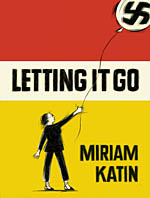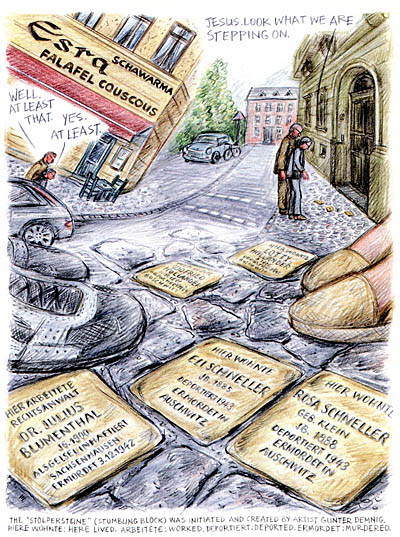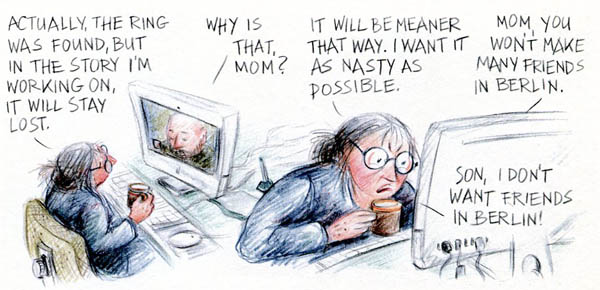 By Miriam Katin
By Miriam Katin
160 pages, color
Published by Drawn & Quarterly
Miriam Katin is a comic creator whose work I’ve been following for over a decade now; encountering her stories in the Monkeysuit anthologies, watching her make a jump to the oversized Drawn & Quarterly Vol. 4, and then her first graphic novel We Are On Our Own. Her stories of her life as a Jewish Hungarian immigrant offer a glimpse into a life that will be unfamiliar to most, and she’s always had a strong skill as a storyteller. Her new graphic novel Letting It Go is in many ways the most personal one yet, focusing on the news that her son is planning to move to Berlin. What results is a frank and slightly comedic story about trying to let go of one’s anger.
Katin’s story in Letting It Go is a mixture of humor and drama; this is a book where at one moment she’s trying to deal with a cockroach invasion in the apartment that Katin and her husband Geoff live in, and the next she’s reeling from the news that her son Ilan is moving to Berlin and applying for Hungarian citizenship. "The fact that he’s in Berlin, it’s a horror," Katin tells her aging mother, and later thinks as she looks through the citizenship application, "This is like handing my baby over to the wolves." She doesn’t mince words in Letting It Go, and in doing so you get a strong sense of just how much of a shock to her system this move is. And with that, Katin takes you with her on a journey of understanding and releasing some of her anger.

 There’s an interesting sequence near the end of the book where Katin and her husband have visited a museum in Berlin, and Geoff had placed his wedding ring in a box for the metal detectors, only to later realize it wasn’t back on his hand. The ring isn’t at the security system, and Geoff and Katin are convinced that someone stole it. It’s not until Geoff is telling the story to others later that he angrily pulls off his jacket, and the missing ring flies out of a pocket. "In the story I’m working on, it will stay lost," Katin tells Ilan. "It will be meaner that way. I want it as nasty as possible." That incident tells simultaneously does several things within the context of Letting It Go. It reminds us that the events of this book are all through Katin’s admittedly skewed perspective. It makes you wonder how much liberty she took in recounting these stories. Most importantly, it lets you in at this point on how her long-held opinions on Germany are starting to soften, since ultimately she didn’t change what happened for the purposes of making Letting It Go meaner. In many ways, Katin seems to be the one surprised by the ending of her own autobiographical book; she tries to steer it towards one conclusion, but even she can’t stop it from course correcting. As she starts to find things familiar in Germany and even goes through the expense of a second trip there for an art opening, one gets the impression that she’s not as intractable as Katin wants us to believe she is.
There’s an interesting sequence near the end of the book where Katin and her husband have visited a museum in Berlin, and Geoff had placed his wedding ring in a box for the metal detectors, only to later realize it wasn’t back on his hand. The ring isn’t at the security system, and Geoff and Katin are convinced that someone stole it. It’s not until Geoff is telling the story to others later that he angrily pulls off his jacket, and the missing ring flies out of a pocket. "In the story I’m working on, it will stay lost," Katin tells Ilan. "It will be meaner that way. I want it as nasty as possible." That incident tells simultaneously does several things within the context of Letting It Go. It reminds us that the events of this book are all through Katin’s admittedly skewed perspective. It makes you wonder how much liberty she took in recounting these stories. Most importantly, it lets you in at this point on how her long-held opinions on Germany are starting to soften, since ultimately she didn’t change what happened for the purposes of making Letting It Go meaner. In many ways, Katin seems to be the one surprised by the ending of her own autobiographical book; she tries to steer it towards one conclusion, but even she can’t stop it from course correcting. As she starts to find things familiar in Germany and even goes through the expense of a second trip there for an art opening, one gets the impression that she’s not as intractable as Katin wants us to believe she is.
If you’ve never seen Katin’s art before, it’s a real treat. Drawn with colored pencils, Katin’s art is a beautiful mixture of carefully realized portraits and scribbles. Her animation background is very much on display in her art; when Geoff is storming down the street while steam blasts out of his ears, I love the almost excited way that Katin draws herself squeeze up next to Geoff and putting her hand on his arm. The next image has her in front of him, and your mind fills in the interstitial image of her swinging around; through posture and the illusion of movement, Katin finds a way to have her drawings figuratively come to life. At times Katin’s art is whimsical and entertaining, like her getting buffeted around the page by musical notes from Ride of the Valkyries. As the art retreats into a single color, the stark nature of her drawings combined with the funny action on display is eye-catching, a sudden shift into something that contains both whimsy and a serious point. Compare those with the full-color portraits that are carefully rendered throughout the book. When Katin draws the Stolpersteine (a series of memorial plaques to those dying in concentration camps, embedded in the cobblestone street), it’s a moment of beauty amidst a deeply depressing scene. Her colors are so vivid, her attention to detail so sharp, it’s hard to not get instantly drawn in.

The best thing about Letting It Go, I think, is that Katin doesn’t present her ultimate change of heart through any one huge moment of discovery. Rather, it’s a gradual shift over time, one that lets some of that anger slip away bit by bit. Doing so presents the story not only more believable, but I think more interesting. For a book that isn’t afraid to take flights of fancy to show Katin shopping to a gift for herself, or noting that she recently "accepted the dry martini as [her] personal savior," it’s a book that plumbs the depths of Katin’s spirit. The end result? Letting It Go is that rare autobiographical story that holds real interest for readers from all walks of life. Once again, Katin’s created a real winner.
Purchase Links: Amazon.com | Powell’s Books
